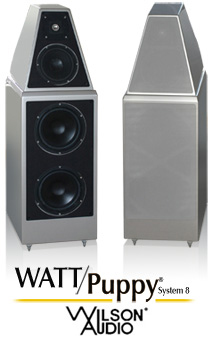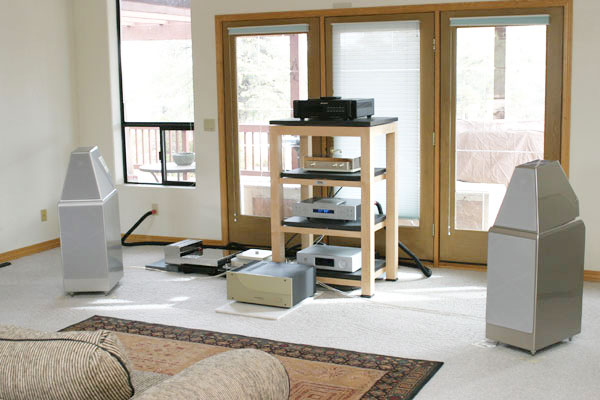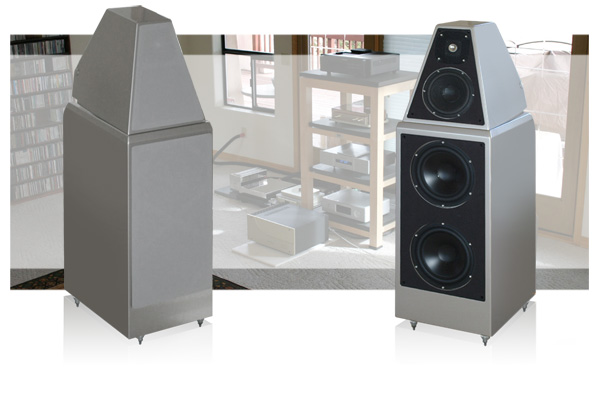![[SoundStage!]](../../titles/sslogo3.gif) Home
Audio Equipment Home
Audio EquipmentFeature Review |
|||||
The System 8 is the third version of the WATT/Puppy I've written about, and all three share a few distinctive traits that go a long way toward defining the overall sound of this well-known speaker. Historically, WATT/Puppys have been very detailed, very dynamic speakers with tremendous low-frequency depth, weight and impact. All of these things describe the WATT/Puppy 8. Its ability to resolve musical information and untangle dense or complicated recordings is consummate and complete. What you hear -- the feathery strumming of a guitar or the massive reverberations of a bass-drum whack -- and how you hear it -- via the speed into and out of each note and the overall presence of the performers -- are deftly balanced. There is no deconstructive analysis, no highlighting, no presentation of detail for its own sake. Instead there is integration -- a presentation in which the sonic elements fuse into a comprehensive, impressive whole. Two rather different-sounding recordings illustrate this. The piano on Jean-Yves Thibaudet's Conversations with Bill Evans [London 455 512-2] and the Daniel Barenboim recording of Argentinean music, Mi Buenos Aires Querido [Teldec 0630-13474-2], sound very different, even though both are less than ten years old. In the case of the former, Thibaudet's playing sounds much more dry, and hall ambience is emphasized. In the latter, Barenboim's piano sounds big and redolent with overtone. The WATT/Puppy 8 makes the differences plain, but it doesn't accentuate either the recorded space or the size of the instrument. This is an exceedingly honest speaker, yet one that doesn't become merciless. Truth and beauty are often at odds in audio equipment; too much of one leads to too little of the other. I've maintained since I began writing audio reviews that the very best equipment balances both. While earlier WATT/Puppys may have been heavy on the truth, more contemporary versions have sounded beautiful as well. The WATT/Puppy 8 reveals what's on each recording with great precision, but it does so in a thoroughly pleasing way. Because of its high sensitivity and exceedingly low intrinsic distortion, the WATT/Puppy 8 doesn't lose musical detail to its own noise floor when playing at low levels. On the other end, it can deliver an orchestral crescendo or searing guitar chord at an amplifier's full power without rattling the sonic presentation apart. Of course, this means it has a very wide dynamic range; only the bigger Wilson Audio speakers can play more expertly from very soft to deafeningly loud among the dynamic speakers I've heard. This is something I've found unique to Wilson Audio speakers. Horn-loaded and single-driver designs can play at high levels with only a watt or two, but their tonal aberrations are so great that they cannot suspend disbelief, at least to my ears. Dynamic speakers can get the tone right, but some of them sound compressed, even with several hundred watts of power behind them. The WATT/Puppy 8, though, sounds pure and delicate with only a few watts, or like a sonic sledgehammer with the full output of a solid-state bruiser behind it. It has the widest applicability of any speaker I know, combining the sonic advantages of disparate technologies.
The depth and power of the WATT/Puppy 8's bass belie the speaker's modest dimensions: 43 3/8" high with the spikes installed, 13" wide, and 18 3/4" deep. Of course, much of this size is due to the Puppy, which houses a pair of proprietary Scan-Speak-sourced 8" woofers in a rear-ported cabinet. The System 8 broadcasts the delicate bloom of the upright bass from the Wood Brothers' Ways Not to Lose [Blue Note 0946 3 43120 2 8] and the pulsing power of the deep throbs on "3000 Miles" from Tracy Chapman's Where You Live [Elektra 83803-2] with equal assurance. When bass is sloppy, you hear it, and the same is true when it acts in pistonic fashion, in which case it comes and goes without overhang or shadowing. This is what loudspeakers should do, but so many, especially those whose bass is noteworthy with one cut or another, fall short. I credit the Puppy cabinet here. For David Wilson, a speaker cabinet is an organic thing. Its design is not simply a matter of utter inertness -- which is impossible -- but finding the right materials for each application and thereby addressing the drivers' outputs in unadulterated and musically consonant ways. The properties of Wilson Audio's X material create a platform from which even the most powerful low frequencies start and stop in a realistic manner. If you've read my reviews of the WATT/Puppy 6 and 7, you pretty much already know everything I've written so far about the sound of the System 8. Detail retrieval, dynamic prowess and bass power are all present and accounted for. However, there are two specific areas in which the System 8 improves on its predecessors, and these make the newest WATT/Puppy the best of the bunch by an ample margin. First, the WATT/Puppy 8 is a more linear speaker than earlier iterations, one with fewer tendencies and idiosyncrasies. The System 8 presents the signal with even greater fidelity than its predecessors. The WATT/Puppy has always had a rather American sound, one whose massive dynamics and bass energy compensated for room effects. We in the US have larger, lossier listening rooms than most audiophiles in Europe and Asia -- just the kind of environments in which a speaker like the WATT/Puppy thrives. Any full-range speaker can overload an inappropriate room, but you can adjust the WATT/Puppy 8 for smaller, tighter rooms that may be overwhelmed by the profound low frequencies of which this speaker is capable. This is done via a barrel resistor in the bottom of the Puppy. According to Wilson Audio, it is rarely needed now. The WATT/Puppy 8 is certainly still dynamic and has remarkable bass, but neither trait is pronounced, leading to a more even, honest presentation. At CES, Dave Gordon of Audio Research used a CD of famous jazz numbers -- "Milestones," "So What" -- played on guitar and mandolin with minimal drum and bass accompaniment. I've been playing the CD -- Jerry Garcia and David Grisman's So What [Acoustic Disc ACD-33] -- ever since. I marvel at the vitality and momentum of this music played on instruments for which it was not written. With Garcia's guitar and Grisman's mandolin in opposite channels, the WATT/Puppy 8 unfolds the soundstage with such crispness that walking amongst the musicians seems possible. Different amplification can take some of the edge off such extreme focus or hone it a little more, the WATT/Puppy 8 passing along what's upstream with exceptional fidelity. The WATT/Puppy has always been an effective reviewing tool, and the System 8 is an even better one. But lest you think that the WATT/Puppy has reverted to its early studio-monitor days, the System 8 is not merciless in its chasing of the signal's purity. It retains its intrinsic beauty, and may perhaps sound a bit more radiant because of its evenhanded approach. Thinking back to my earlier reviews, it seems inconceivable for the WATT/Puppy to become a more truthful speaker without affecting its sheer music-making abilities, but it has. I can only speculate, but I would guess that the new tweeter and WATT cabinet are responsible for this, the former offering up more musical information and the latter reducing the speaker's own self-generated noise to a new low point. Thus, there's more signal and less distortion to corrupt it, making for cleaner sound.
The second area in which the System 8 trumps its ancestors is coherence -- the drivers' coalescence into a uniform presentation. This was a big challenge for early WATT/Puppys, and it is still an issue for many of the speakers that have tried to adopt the two-cabinet platform. But the System 6 and 7 made strides forward in terms of sonic oneness, and the System 8 takes a giant step down that same road. The WATT/Puppy 8 is now one of the most cohesive-sounding multi-driver dynamic speakers on the market. In fact, I can't think of one that's better. High to low, the System 8 is steady and unbroken in tonal quality, sounding neither forward nor recessed, warm nor cool, lean nor rich. This makes the WATT/Puppy 8 a speaker for all kinds of music, not one that sounds best with classical or jazz but falls apart with electrified rock. While the speaker's sheer resolving power and extension at both extremes contribute to this, it is the way the drivers unite that pulls it all together. In this regard, the System 8 isn't alone in the Wilson Audio line. The Sophia 2 ($13,990 per pair) is also a very coherent speaker -- and markedly better in this regard than earlier WATT/Puppys. Differences exist between the Sophia 2 and WATT/Puppy 8, but you will need to hear the speakers one after another with a wide range of music to appreciate them fully. This is a testament to the quality of the Sophia 2, which, when its cost is considered, might be Wilson Audio's highest sonic accomplishment to date. I stick by that even as I acknowledge that the WATT/Puppy 8 is the better speaker. The System 8's bass does extend lower, and it has increased weight and slam with a capable amplifier. But the bigger discrepancies happen elsewhere, likely due to the dynamics inherent in the 4dB difference in sensitivity between the two speakers. Sensitivity is not just about ultimate loudness; you can hear its effect even when an audio system is loping along at a low level. The WATT/Puppy 8 sounds more frank and freewheeling than the Sophia 2. It is also the more focused speaker, which leads to images that are more tightly defined and arranged in space in a more precise manner. In fact, "precise" is a good way to sum up: The WATT/Puppy 8 is the more precise speaker, while the Sophia 2 is ever so slightly sweeter.
The MAXX 2 ($48,000 per pair) is another issue altogether, capable of reproducing the scale and dynamic range of a performance in a way that the WATT/Puppy 8 can't equal. With the MAXX 2s, a big soundstage is bigger still, and solo performers float alone in space. These big speakers disappear like small ones, which is one of the most surprising things about them and the even larger Alexandria X-2s. This is where Wilson Audio's group delay adjustments (and in the case of the X-2, aspherical group delay, with each driver's position adjusted forward and back, up and down) makes its importance known. Once properly set up, the speakers leave only the sound they make behind them, which is an optical illusion given their sheer mass. Still, the WATT/Puppy 8 is the speaker sonically closest to the MAXX 2 -- a Mini MAXX (or Maxi Sophia), if you will. But moving up the Wilson Audio line is not so much a matter of simply achieving more -- more bass, dynamics, you name it. You do get a speaker that expands the performance envelope, but the model below remains undiminished and distinct, a rarity in the audio world and a notion that turns the idea of value on its head. The question I answer most often about Wilson Audio speakers is, Which one should I buy? Potential owners often have the budget for two different models, and they want to know which one would be better given their rooms and ancillary equipment. I still subscribe to what I wrote in my sidebar to Ken Choi's review of the Sophia 2: "The best Wilson Audio speaker is the one you happen to be listening to." The point here is that when you're hearing the Sophia 2, for example, you don't necessarily start thinking what that jump up in price to the WATT/Puppy 8 might bring. The Sophia 2 is so accomplished and distinct that living with it doesn't involve compromise. In fact, every time I listen to it, I think there's no good reason to consider one of the pricier Wilson Audio speakers. But the same is now true of the WATT/Puppy 8, and perhaps even more so because of its rich past. It's a state-of-the-art small floorstanding speaker, and a speaker of historical importance too. Would I live with it after hearing the X-2 and MAXX 2? Oh, yeah. What I find most intriguing about the WATT/Puppy 8, however, has nothing to do with the speaker itself. Instead, I wonder where Wilson Audio goes from here. More research in materials? Better drivers, perhaps manufactured completely at Wilson Audio? Many speaker makers today see moving their manufacturing to Asia as progress, but not Wilson Audio, whose craftsmen understand their jobs to a degree that simply can't be duplicated in another country. Cheap Asian labor may be good for stock dividends and CEO compensation packages, but it's bad for the artisan spirit of audio's highest end. No matter. Even with all of the thought and engineering that have gone into the WATT/Puppy 8 and will go into future models of this time-honored speaker, it's the destination, not the road taken to get there, that's important. ...Marc Mickelson
|
|||||
|
|||||
![[SoundStage!]](../../titles/sslogo3.gif) All
Contents All
ContentsCopyright © 2007 SoundStage! All Rights Reserved |



